Executive Summary
The exponential growth of data-intensive technologies—such as artificial intelligence, edge computing, and cloud services—has placed unprecedented pressure on data center infrastructure. Traditional manual fiber optic management, characterized by slow processes and human error, struggles to meet these demands. FiberSmart, with its pioneering ROME (Robotic Optical Management Engine) platform, introduces a transformative solution: robotic automation of fiber connectivity. This whitepaper explores how FiberSmart’s innovation addresses key challenges in data center operations, enhancing efficiency, scalability, and resilience while setting a new benchmark for the industry.
The Challenge of Traditional Fiber Connectivity
Fiber optic networks form the backbone of modern data centers, enabling high-speed, low-latency communication critical to digital ecosystems. Yet, the conventional approach to managing these networks relies on manual labor. Technicians physically splice and connect fibers through patch panels, documenting configurations in static spreadsheets. This method is labor-intensive, prone to errors (which contribute to over 30% of network downtime), and difficult to scale. As data centers expand to support hyperscale and edge deployments, these inefficiencies threaten operational reliability, security, and cost-effectiveness.
FiberSmart’s ROME: A Robotic Breakthrough
FiberSmart’s ROME platform reimagines fiber connectivity through advanced robotics and software integration. By automating the physical layer and introducing dynamic network management, ROME delivers a solution that is faster, more accurate, and future-ready.
Automation of the Physical Layer
At the heart of ROME are two software-directed robots within each unit, managing a matrix of hundreds of fiber optic connections. These robots autonomously link servers, switches, and other network devices, completing tasks in seconds that once took hours or days. This eliminates human error, reduces downtime, and frees technicians from repetitive, onsite work. The result is a physical infrastructure that operates with precision and consistency, even under high demand.
Software-Defined Network Management
ROME pairs its robotic hardware with an intuitive software interface, enabling administrators to configure and reconfigure connections remotely. A drag-and-drop dashboard replaces cumbersome manual logs, while real-time visualization of the network’s physical layout provides unparalleled transparency. This software-defined approach not only accelerates operational workflows but also enhances security by minimizing human access to critical infrastructure—a vital consideration in today’s threat landscape.
Adaptive and Scalable Design
The platform’s adaptability sets it apart as a solution for the future. ROME can dynamically adjust server capacity, reroute traffic around damaged cables, and support seamless upgrades by autonomously identifying and managing connectors. This flexibility is essential for data centers powering AI workloads and edge computing, where rapid scalability and uninterrupted service are non-negotiable. FiberSmart’s system ensures networks can evolve alongside technological advancements without costly overhauls.
Resilience and Longevity
Built for durability, ROME is engineered to withstand extreme conditions, including power outages and environmental disruptions. Its mechanical latching mechanism ensures optical circuits remain active without electricity, while a lifespan rated for millions of connection cycles guarantees decades of reliable performance. This resilience makes ROME a strategic investment for operators aiming to future-proof their facilities.
Benefits of FiberSmart’s Innovation
- Efficiency: Connections completed in seconds, reducing operational delays.
- Reliability: Elimination of human error, minimizing downtime and service interruptions.
- Security: Reduced onsite human intervention, lowering physical and cyber risks.
- Scalability: Dynamic capacity adjustments to meet growing network demands.
- Cost-Effectiveness: Long-term durability and automation decrease maintenance and labor costs.
Implications for the Data Center Industry
FiberSmart’s ROME platform represents a paradigm shift, moving fiber connectivity from a manual bottleneck to an intelligent, automated process. This innovation aligns with the industry’s trajectory toward unmanned, software-driven data centers capable of supporting the digital economy’s relentless expansion. As enterprises and providers grapple with increasing data volumes and complexity, solutions like ROME offer a competitive edge, enabling faster deployment, higher uptime, and greater operational agility.
Conclusion
FiberSmart’s robotic approach to fiber connectivity, embodied in the ROME platform, is a game-changer for data centers. By integrating precision robotics, software control, and real-time analytics, it addresses the inefficiencies of traditional methods while preparing infrastructure for future challenges. As the demand for robust, scalable networks intensifies, FiberSmart stands at the forefront, delivering a smarter, more resilient foundation for the data-driven world.
About FiberSmart
FiberSmart is a leader in data center innovation, committed to advancing network infrastructure through cutting-edge technology. With ROME, the company empowers operators to achieve unparalleled efficiency and reliability, driving the evolution of connectivity in the digital age.











